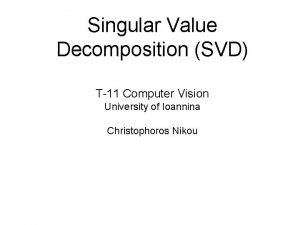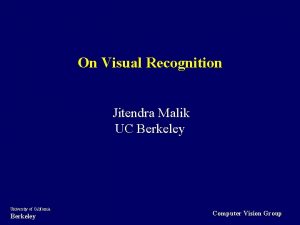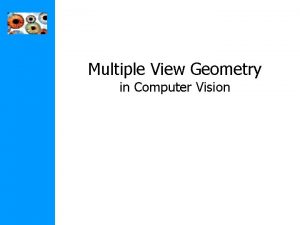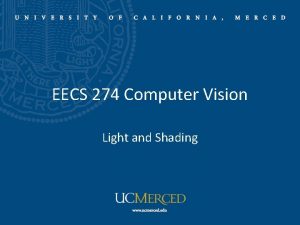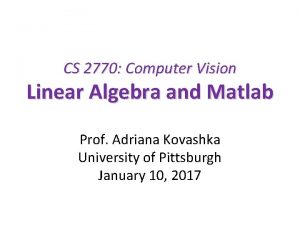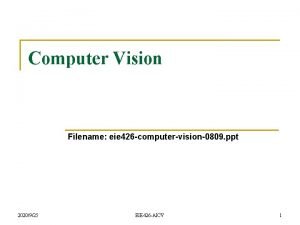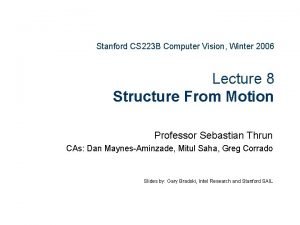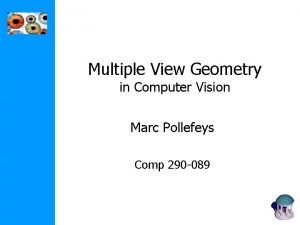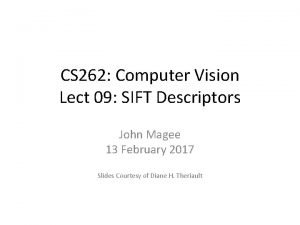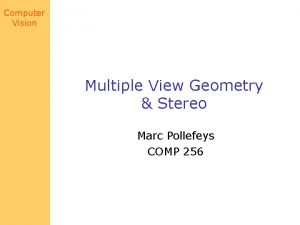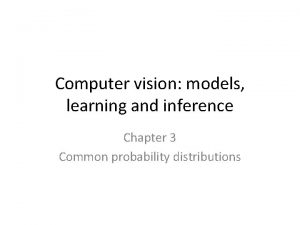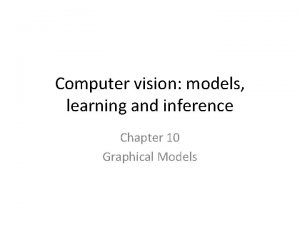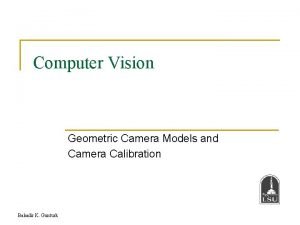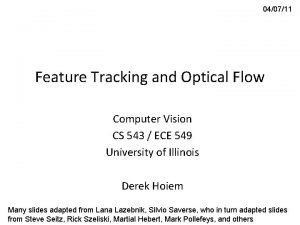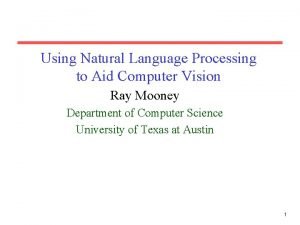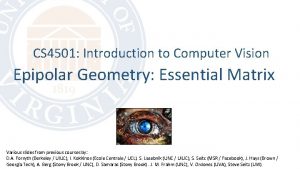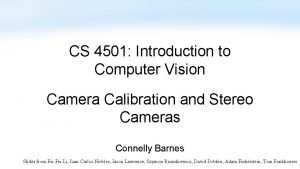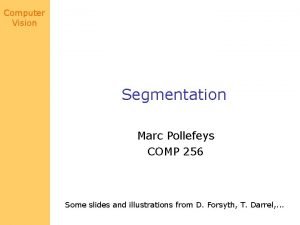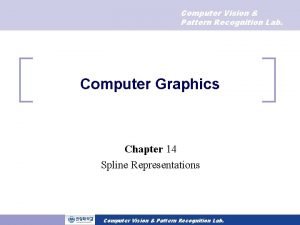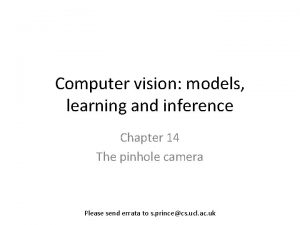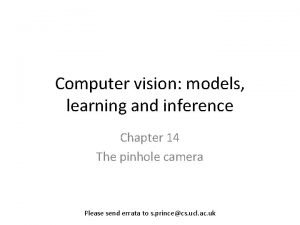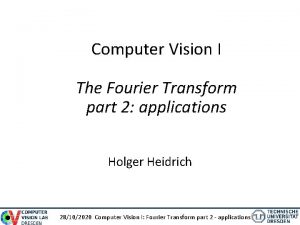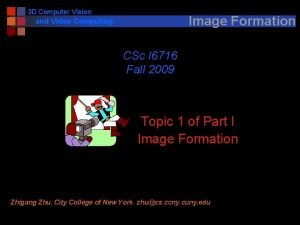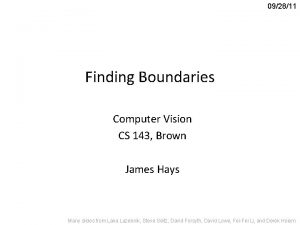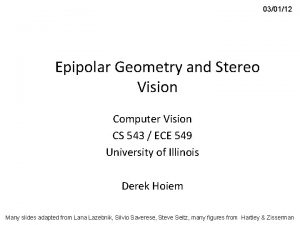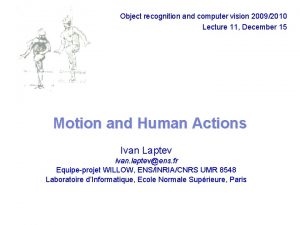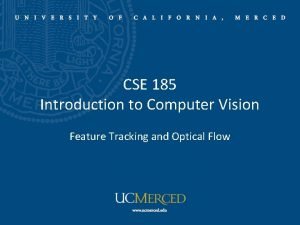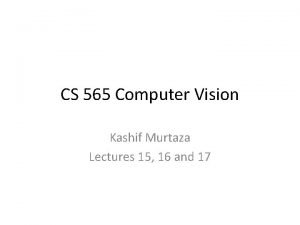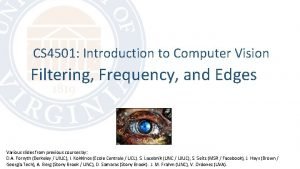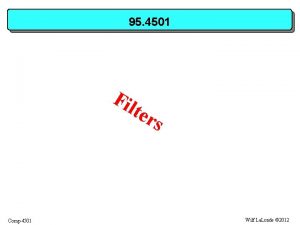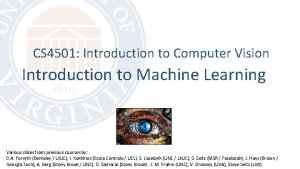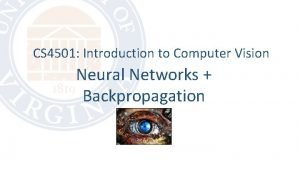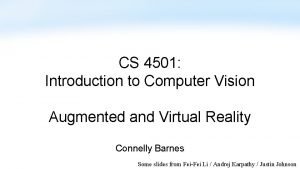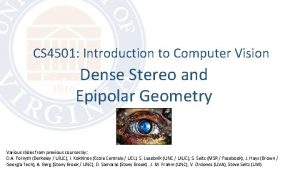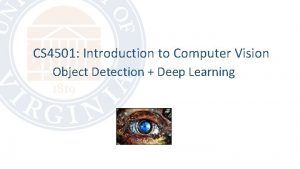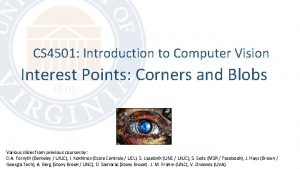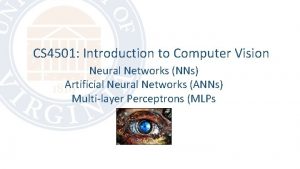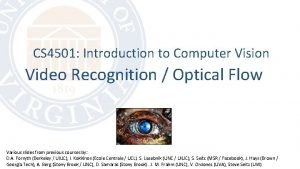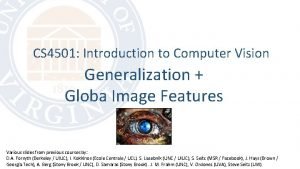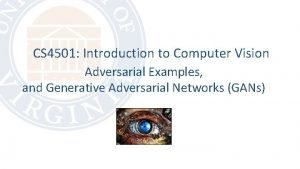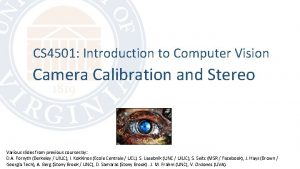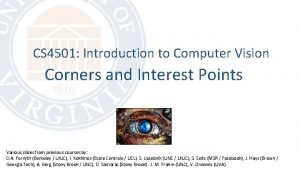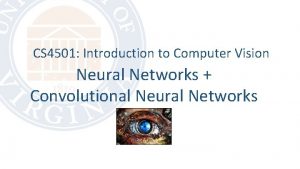CS 4501 Introduction to Computer Vision Frequency Edges


















































- Slides: 50

CS 4501: Introduction to Computer Vision Frequency, Edges, and Corners Various slides from previous courses by: D. A. Forsyth (Berkeley / UIUC), I. Kokkinos (Ecole Centrale / UCL). S. Lazebnik (UNC / UIUC), S. Seitz (MSR / Facebook), J. Hays (Brown / Georgia Tech), A. Berg (Stony Brook / UNC), D. Samaras (Stony Brook). J. M. Frahm (UNC), V. Ordonez (UVA).

Last Class • Google Colaboratory • Recap on Convolutional Operations • Image Gradients: The Sobel Operator • Frequency Domain

Today’s Class • Frequency Domain • Filtering in Frequency • Edge Detection - Canny • Corner Detection - Harris

From Time to Frequency Figure by National Instruments

Example Slide by Emmanuel Agu

Crucial Missing Step (Leap) from Last Class http: //www. personal. soton. ac. uk/jav/soton/HELM/workbooks/workbook_23/23_6_complex_form. pdf

Discrete Fourier Transform Inverse Discrete Fourier Transform

More generally for images (2 D DFT and i. DFT)

Keep in mind Euler’s Equation We can compute the real and the imaginary part of the complex number.

Fourier Transform • Fourier transform stores the magnitude and phase at each frequency • Magnitude encodes how much signal there is at a particular frequency • Phase encodes spatial information (indirectly) • For mathematical convenience, this is often notated in terms of real and complex numbers Amplitude: Phase: Slide by James Hays

Discrete Fourier Transform - Visualization Slide by A. Zisserman

Image Filtering in the Frequency Domain Slide by A. Zisserman

Image Filtering in the Frequency Domain Slide by A. Zisserman

Image Filtering in the Frequency Domain Slide by A. Zisserman

Image Filtering in the Frequency Domain Slide by A. Zisserman

The Convolution Theorem • The Fourier transform of the convolution of two functions is the product of their Fourier transforms • Convolution in spatial domain is equivalent to multiplication in frequency domain! How can this be useful?

Blurring in the Time vs Frequency Domain Example by A. Zisserman

Blurring in the Time vs Frequency Domain Example by A. Zisserman

Blurring in the Time vs Frequency Domain Example by A. Zisserman

Why Frequency domain? • Because the Discrete Fourier Transform can be computed fast using the Fast Fourier Transform FFT algorithm. • Because the running time does not depend on the size of the kernel matrix. • However rarely used these days because most filters used in Computer vision are 3 x 3, 5 x 5, e. g. relatively small.

Final Thoughts – JPEG Image Compression • Small amount of information can recover almost the original image with some loss in resolution. • Images are dominated by low frequency information. e. g. no need to store repeated pixels. • In practice JPEG uses a simpler transformation called Discrete Cosine Transform DCT.

Edge Detection

Edge Detection • Goal: Identify sudden changes (discontinuities) in an image • Intuitively, most semantic and shape information from the image can be encoded in the edges • More compact than pixels • Ideal: artist’s line drawing (but artist is also using object-level knowledge) Source: D. Lowe

Why do we care about edges? • Extract information, recognize objects • Recover geometry and viewpoint Source: J. Hays Vanishing line Vanishing point Vertical vanishing point (at infinity) Vanishing point

Origin of Edges surface normal discontinuity depth discontinuity surface color discontinuity illumination discontinuity • Edges are caused by a variety of factors Source: Steve Seitz

Edge Detection • Back to Sobel But Ideally we want an output where: g(x, y) = 1 if edge g(x, y) = 0 if background

Edge Detection • Sobel + Thresholding

• Sobel + Thresholding Problems: • Edges are too wide: We want 1 -pixel wide edges if possible. • Lots of disconnected edges: We want to respect continuity or connectivity.

Solution: Canny edge detector • Suppress Noise • Compute gradient magnitude and direction • Non-Maximum Suppression • Hysteresis and connectivity analysis Similar to Sobel: Blurring + Gradients

Example • original image Source: Juan C. Niebles and Ranjay Krishna.

Derivative of Gaussian filter x-direction y-direction Source: Juan C. Niebles and Ranjay Krishna.

Compute gradients (Do. G) X-Derivative of Gaussian Y-Derivative of Gaussian Gradient Magnitude Source: J. Hays

Get orientation at each pixel Source: J. Hays

Compute gradients (Do. G) X-Derivative of Gaussian Y-Derivative of Gaussian Gradient Magnitude Source: Juan C. Niebles and Ranjay Krishna.

Canny edge detector • Suppress Noise • Compute gradient magnitude and direction • Apply Non-Maximum Suppression • Assures minimal response Source: Juan C. Niebles and Ranjay Krishna.

Non-maximum suppression • Edge occurs where gradient reaches a maxima • Suppress non-maxima gradient even if it passes threshold • Only eight angle directions possible • Suppress all pixels in each direction which are not maxima • Do this in each marked pixel neighborhood Source: Juan C. Niebles and Ranjay Krishna.

Remove spurious gradients is the gradient at pixel (x, y) Source: Juan C. Niebles and Ranjay Krishna.

Non-maximum suppression • Edge occurs where gradient reaches a maxima • Suppress non-maxima gradient even if it passes threshold • Only eight angle directions possible • Suppress all pixels in each direction which are not maxima • Do this in each marked pixel neighborhood Source: Juan C. Niebles and Ranjay Krishna.

Non-maximum suppression At q, we have a maximum if the value is larger than those at both p and at r. Interpolate to get these values. Source: D. Forsyth

Non-max Suppression Before After Source: Juan C. Niebles and Ranjay Krishna.

Canny edge detector • Suppress Noise • Compute gradient magnitude and direction • Apply Non-Maximum Suppression • Assures minimal response • Use hysteresis and connectivity analysis to detect edges Source: Juan C. Niebles and Ranjay Krishna.

Source: Juan C. Niebles and Ranjay Krishna.

Hysteresis thresholding • Avoid streaking near threshold value • Define two thresholds: Low and High • If less than Low, not an edge • If greater than High, strong edge • If between Low and High, weak edge Source: Juan C. Niebles and Ranjay Krishna.

Hysteresis thresholding If the gradient at a pixel is • above High, declare it as an ‘strong edge pixel’ • below Low, declare it as a “non-edge-pixel” • between Low and High • Consider its neighbors iteratively then declare it an “edge pixel” if it is connected to an ‘strong edge pixel’ directly or via pixels between Low and High Source: Juan C. Niebles and Ranjay Krishna.

Hysteresis thresholding strong edge pixel weak but connected edge pixels strong edge pixel Source: S. Seitz

Final Canny Edges Source: Juan C. Niebles and Ranjay Krishna.

Canny edge detector 1. Filter image with x, y derivatives of Gaussian 2. Find magnitude and orientation of gradient 3. Non-maximum suppression: • Thin multi-pixel wide “ridges” down to single pixel width 4. Thresholding and linking (hysteresis): • Define two thresholds: low and high • Use the high threshold to start edge curves and the low threshold to continue them Source: Juan C. Niebles and Ranjay Krishna.

Canny Edge Detector • Classic algorithm in Computer Vision / Image Analysis • Commonly implemented in most libraries • e. g. in Python you can find it in the skimage package. Open. CV also has an implementation with python bindings.

Corners (and Interest Points) • How to find corners? What is a corner?

Questions? 50
 Human vision vs computer vision
Human vision vs computer vision What is a joint relative frequency
What is a joint relative frequency Expected relative frequency
Expected relative frequency Peak factor formula
Peak factor formula Vmax shm
Vmax shm Relative frequency bar chart
Relative frequency bar chart Marginal frequency table
Marginal frequency table How to find conditional relative frequencies
How to find conditional relative frequencies 16-385 cmu
16-385 cmu Kalman filter computer vision
Kalman filter computer vision Svd example
Svd example Berkeley computer vision
Berkeley computer vision Multiple view geometry
Multiple view geometry Font detector
Font detector Radiometry in computer vision
Radiometry in computer vision Linear algebra for computer vision
Linear algebra for computer vision Impoverished motion examples
Impoverished motion examples Computer vision models learning and inference
Computer vision models learning and inference Watershed segmentation
Watershed segmentation Computer vision stanford
Computer vision stanford Multiple view geometry in computer vision
Multiple view geometry in computer vision Azure computer vision python
Azure computer vision python Mathematical foundations of computer graphics and vision
Mathematical foundations of computer graphics and vision Computer vision slides
Computer vision slides Ilsvrc-2012
Ilsvrc-2012 Computer vision final exam
Computer vision final exam Computer vision sift
Computer vision sift Multiview geometry in computer vision
Multiview geometry in computer vision Computer vision: models, learning, and inference
Computer vision: models, learning, and inference Computer vision: models, learning, and inference pdf
Computer vision: models, learning, and inference pdf Geometric camera calibration
Geometric camera calibration Aperture problem computer vision
Aperture problem computer vision Computer vision vs nlp
Computer vision vs nlp Epipolar geometry computer vision
Epipolar geometry computer vision Zed camera calibration
Zed camera calibration Computer vision
Computer vision Sampling in computer vision
Sampling in computer vision Computer vision
Computer vision Computer vision
Computer vision Computer vision
Computer vision Computer vision
Computer vision Fourier transform computer vision
Fourier transform computer vision Image formation computer vision
Image formation computer vision Computer vision brown
Computer vision brown Computer vision brown
Computer vision brown Epipolar geometry computer vision
Epipolar geometry computer vision Computer vision brown
Computer vision brown Szeliski computer vision
Szeliski computer vision Computer vision
Computer vision Aperture problem computer vision
Aperture problem computer vision Murtaza computer vision
Murtaza computer vision










